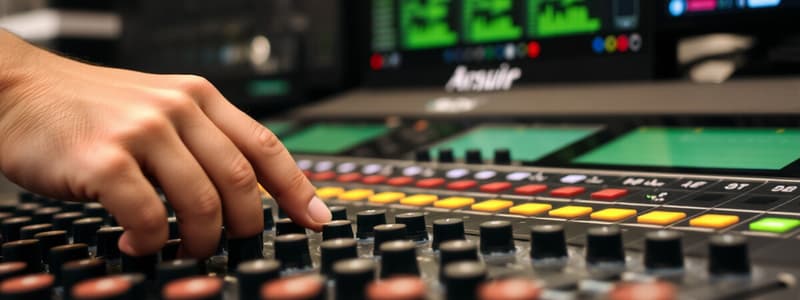Podcast
Questions and Answers
Why is it not a good idea to work on the original session file?
Why is it not a good idea to work on the original session file?
It is good practice to always work on a copy of an original session file.
What should you do first when receiving an original session file?
What should you do first when receiving an original session file?
Back it up in three separate locations.
What should you trim regardless of when it was recorded?
What should you trim regardless of when it was recorded?
The heads and tails of takes.
What happens to edits if they don't contain any crossfades?
What happens to edits if they don't contain any crossfades?
Why is it a good practice to have crossfades on every edit?
Why is it a good practice to have crossfades on every edit?
What should you do once all edits, comping, and tuning are complete?
What should you do once all edits, comping, and tuning are complete?
Why is it important to clearly label each track?
Why is it important to clearly label each track?
What are major timesavers in any DAW?
What are major timesavers in any DAW?
How do veteran mixers use memory locations and window configurations?
How do veteran mixers use memory locations and window configurations?
Why are subgroups useful in a mix?
Why are subgroups useful in a mix?
How do subgroups work best?
How do subgroups work best?
What should you do with channels that use a particular effect?
What should you do with channels that use a particular effect?
Why do the kick, snare, bass, and vocal usually need a compressor during the mix?
Why do the kick, snare, bass, and vocal usually need a compressor during the mix?
What are some things you should do to calibrate your hearing when preparing to mix?
What are some things you should do to calibrate your hearing when preparing to mix?
What happens if you close your eyes while mixing?
What happens if you close your eyes while mixing?
Why should you have a pen and a pad of paper ready to write on while mixing?
Why should you have a pen and a pad of paper ready to write on while mixing?
Study Notes
Session File Management
- Always work on a copy of the original session file to prevent data loss.
- Back up the original session file in three locations: system drive, removable drive, and cloud storage.
- Create a working copy labeled with the session date before making any edits to ensure the original state can be restored.
Editing Practices
- Trim the heads and tails of all takes regardless of when they were recorded to improve overall sound quality.
Importance of Crossfades
- Edits lacking crossfades can cause audible clicks and pops.
- Maintaining crossfades on every edit is considered good practice to ensure smooth transitions between audio clips.
Clip Consolidation
- After completing all edits and tuning, consolidate all clips to enhance session organization and navigation.
Track Labeling
- Clearly label each track to maintain organization within a session, aiding in identifying final takes and facilitating collaboration.
- Use logical names following naming conventions for easy reference and archival purposes.
Time-Saving Techniques
- Utilize memory locations and window configurations to increase efficiency in mixing.
- Veteran mixers often mark important elements and add pre-roll to specific sections.
Subgroups in Mixing
- Subgroups allow collective adjustments of multiple tracks and can apply effects like EQ and compression across groups.
- Setting up subgroups in advance can streamline the mixing process, especially for sections that need dynamic adjustments, like choruses.
Effects Routing
- Apply routing (aux send) to channels that require certain effects, instantiating effects on aux inputs for flexibility.
- If multiple tracks require the same EQ/compression settings, assign them to a subgroup for global effect application.
Compressor Usage
- Kick, snare, bass, and vocal tracks typically require compression to control dynamics for a polished mix.
Hearing Calibration Techniques
- Calibrate hearing pre-mixing by taking breaks from loud sounds, maintaining a healthy diet, relaxing jaw muscles, and adjusting monitor levels appropriately.
Benefits of Closing Eyes
- Closing eyes while mixing enhances three-dimensional sound visualization by reducing visual distractions, which can heighten audio awareness.
Note-Taking During Mixing
- Keep a pen and pad of paper handy while mixing to quickly jot down thoughts, ideas, or setting adjustments that may be forgotten otherwise.
Studying That Suits You
Use AI to generate personalized quizzes and flashcards to suit your learning preferences.
Related Documents
Description
This quiz covers essential practices for handling original session files during mix preparation. Learn why it's crucial to make backups and create working copies before making any changes. Test your understanding of these procedures to ensure data integrity and effective workflow.




